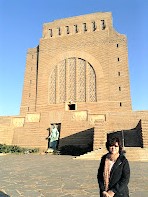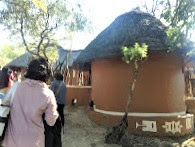The
Voortrekker Monument, built between 1937 and 1949, was erected to commemorate the Great Trek - the migration of Afrikaner pioneers (Voortrekkers) who left the Cape Colony between 1835 and 1854 to settle in the interior regions, including what is now Pretoria. The monument stands strategically on a hill, overlooking the city, symbolizing both remembrance and resilience.
Inside the memorial, our tour guide walked us through the story told by the impressive marble friezes - 72 panels of intricately carved human figures - that depict key moments in the Voortrekkers’ journey.
After the Voortrekkers settled near present-day Pretoria, clashes with the Zulu kingdom became frequent. Seeking to resolve the conflict, the idea of a ceasefire was raised. King Dingane of the Zulu invited Voortrekker leaders under the pretense of peace negotiations. Trusting in the king’s word, Piet Retief, Piet Uys, and about 70 men - including boys - together with 30 servants, entered Zulu territory unarmed. That night, they were betrayed and massacred on Dingane’s orders.
The betrayal enraged the Voortrekkers, who considered it a dishonourable act that demanded justice. They vowed to avenge their fallen comrades.
On 16 December 1838, Andries Pretorius led a commando force of 470 men with 64 wagons into Dingane’s territory. At the Battle of Blood River, they faced an overwhelming Zulu army estimated at 10,000-15,000 strong. Using their wagons as a fortified laager, the Voortrekkers repelled repeated assaults. When the battle ended, some 3,000 Zulu warriors lay dead, while astonishingly, the Boers suffered no casualties.
After this decisive victory, Pretorius secured an alliance with Dingane’s brother, Mpande, which forced Dingane and his supporters into exile. The Voortrekkers interpreted their survival and triumph as a miracle granted by God. In gratitude, they swore a solemn vow that they and their descendants would dedicate the day to God as a day of rest and remembrance.
The commemoration became known as Dingane’s Day, later renamed the Day of the Vow and then the Day of the Covenant, officially recognized as a national public holiday. After the end of apartheid in 1994, the new South African government retained the date as a symbol of unity but renamed it the Day of Reconciliation, a holiday now shared by all South Africans.
The nearby city of Pretoria was named in honour of Andries Pretorius, the Voortrekker leader who secured the historic victory.
According to our guide, every year on 16 December, many Afrikaners (Boers) still gather at the Voortrekker Monument, spending the entire day in prayer and remembrance, keeping alive the vow made by their ancestors.








At exactly 12:00 noon on 16 December each year, a single beam of sunlight passes through a precisely engineered opening in the roof of the Voortrekker Monument and illuminates the cenotaph stone on the ground floor. This remarkable alignment is not only a feat of engineering and astronomy but also carries deep symbolic meaning: the light is said to represent God’s blessing shining down on the Voortrekkers’ vow and sacrifice.
The balcony at the roof has a good view of Pretoria.
After the dismantling of apartheid, political power in South Africa shifted from the white minority to the black majority. The Voortrekker Monument, which could easily have been regarded as controversial - or even offensive to the Zulu people - was nevertheless preserved. Instead of being demolished, it has been reinterpreted as a symbol of reconciliation, acknowledging a painful past while still honouring the cultural memory of the Afrikaners.
Today, the monument also serves as an important heritage attraction and a significant source of foreign exchange for South Africa’s tourism industry. Its removal would not only erase a vital chapter of history but also deprive the nation of an iconic landmark that continues to draw visitors from around the world.
In this regard, Malaysia - where parts of national history have sometimes been reshaped to suit the narrative of a dominant racial group - could learn much from South Africa’s example. The preservation of the Voortrekker Monument shows that even difficult or contested histories can be retained honestly, used for education, and transformed into opportunities for unity rather than division.


























































